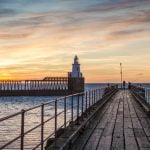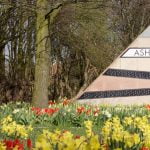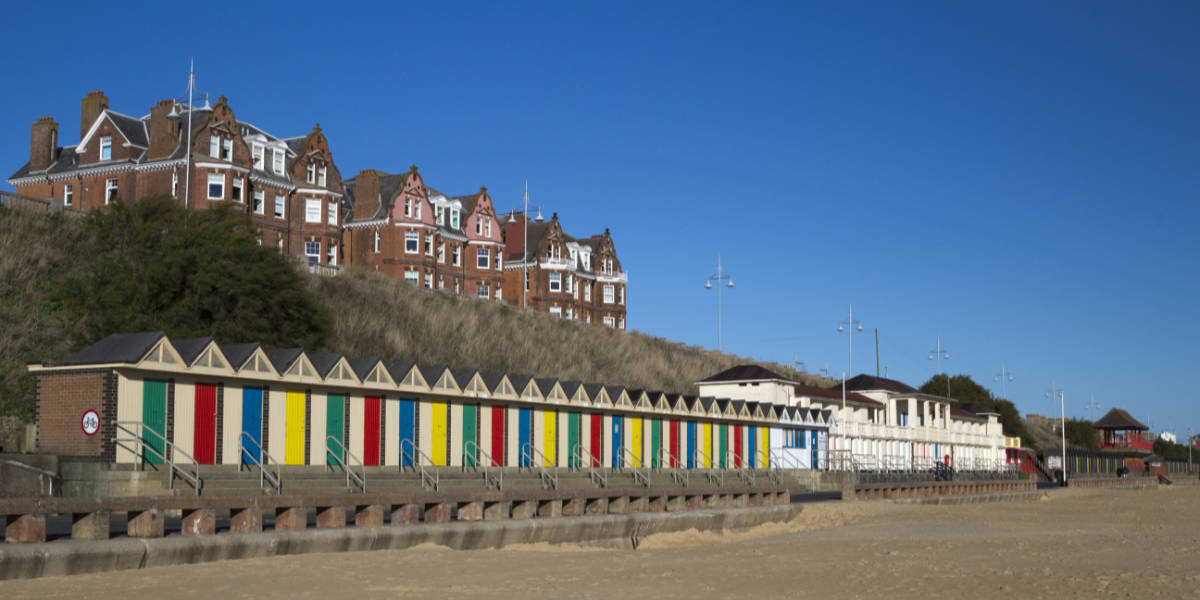
Lowestoft, in sunny Suffolk, is one of the nicest towns in the area. It achieved port status in the ’40s and it hasn’t looked back since. It’s a mild industrial town with a focus on sea life. Although modern Lowestoft has a population of roughly 70,000 people, it took a long time to achieve that growth. New developments in the ’60s might have made it an attractive place to live, but we want to know how it stacks up as a holiday destination… or at least somewhere you wouldn’t mind spending a day.

Image: Brendan M. Allis/Shutterstock.com
Let’s start with the history and work our way forward to how you get there so you can visit for yourself.
Early History in Lowestoft
In the last twenty years, archaeologists have found flint tools in the cliffs to the south of town. These cliffs would have seen occupation about 700k years ago. That’s a long time for any area of land to be occupied. There has been evidence of the town being inhabited all the way down through the ages, too, so if you live there now, you really are living on top of history.
There are traces of Neolithic inhabitants, traces of settlement in the Bronze Age and in the Iron Age, and evidence of both Roman and Viking invasions. We’re not all that fussed on the pre-historic peoples, but let’s take a gander at Roman times in Lowestoft.
Back in 2010, a local found a hoard of 208 Roman coins in a field. It was theorised that they may have come from a soldier’s stash. The silver Denarii were found locally, although the location was not disclosed to the press. They were dated to 1 or 2 AD. In those days, there were no banks. If you wanted to protect your valuables, you buried them. It is likely that a metal detectorist stumbled across someone’s life savings. An archaeological dig in the area revealed evidence of a Roman farm and attracted treasure hunters in the same year. If you are planning on metal detecting around Lowestoft, be sure to check local rules and ask for the landowner’s permission.
Saxon Times
During Saxon times – that’s the period immediately after the Roman’s left when the Vikings were attacking every other day – Lowestoft got its name. It is thought to be a contraction of the Danish name Hlothver and the word for a homestead in Old Norse: Toft. It, therefore, follows that one of those invading Vikings stayed on, started a homestead, and laid the initial foundations for the town it would one day be.
There is a Saxon cemetery at Bloodmoor Hill nearby. The Vikings would have raided along this coastline often since it is on the eastern coast. They had a strong presence in this area, and it is likely that Hlothver’s lands were used as a stopping point or raided by rivals.
The Doomsday Book
By the time of the Domesday Survey, 20 years after the Norman invasion of 1066, Lowestoft is recorded as having 16 households. In those households were 10 smallholders, 3 villagers, and 3 slaves. The Vikings and the old Church in England both kept slaves. These would be captured from raids on villages or bought on slave markets.
The land contained 5 teams for ploughing the 5 acres of meadow, woodland with 8 pigs, 8 cattle, 11 pigs, and 160 sheep. The land belonged to King William and was almost the same in 1066, except for the sheep. Coincidentally, it would be this same replacement of people with sheep that would later cause the Highland Clearances and force the Scots towards coastal life. It would have made the villagers ever more dependant on the sea for food.
Medieval Lowestoft
During Medieval times, Lowestoft continued to experience steady growth. Those original 16 families flourished and grew, most of them taking to the sea themselves. Great Yarmouth and Lowestoft became prominent fishing towns together and would have supplied the inland folks with fish. Suffolk coastal identity has always been tied to fishing, in the case of Lowestoft, Herring would be the main catch of the day for hundreds of years.
During medieval times, herring fishing was a staple trade and food source for the people of Lowestoft. The peak of the herring industry wouldn’t be until after the pier was built in the 19th century, but it began in the Middle Ages and didn’t stop until the 1960s.
Peat cutting was an important part of the culture in medieval Lowestoft too. The villagers would cut parts of the nearby marshes into little squares[i]. These were compact and made of peat, a dense substance that, once dried, makes perfect winter fuel. In areas where there were few trees and before the invention of coal, peat cutting was a massive industry, especially in the north where winters are long and cold. Many peat bogs are now protected.
Significantly, there was a battle in the area (the Battle of Lowestoft) in June 1665. It was the first day of the second Anglo-Dutch war and, since it is in the east, the Dutch attacked the town. The English saw them off, but it sowed a permanent distrust among a town and a country who should have bee brethren. It was Dutch invaders that birthed the town, after all.
Let’s pause the history since there wasn’t all that much happening in the town during the Middle Ages. We’ll look at some fun facts then return to the history in a second.
Lowestoft Trivia
We don’t like to pass any town by without finding out all the gossip we can and passing it off to you lovely readers as trivia. Here are the fun facts we managed to dish out about Lowestoft while we did our research:
- Lowestoft was one of the 50 locations featured in the Iconic 1899 Wills Cigarette Card Set “Seaside Resorts”. The cards are highly sought after nowadays.
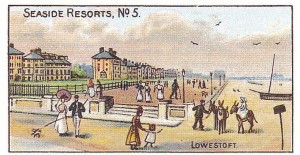
- Lowestoft Porcelain Factory saw the longest production period of any other UK based porcelain producer, excepting Royal Worcester and Royal Crown Derby. It was open from 1757 until 1802.
- Ness Point, outside town, is the first place that the sun rises in the UK. Its eastern situation allows it the title of the most romantic sunrise in England.
- The UK’s largest wind turbine – named Gulliver – is situated here.
- In their best season, the fishermen in Lowestoft took 400 million herring in a single season, with a record 60 million fish landed in a single day here. Overfishing was rife. It’s no wonder there are hardly any fish left on our coastlines.
Now you know what to talk about to impress people when you say you went to Lowestoft for your summer holiday. You’ll even have something to talk about at family dinner.
Industrial Era Lowestoft
The Industrial Revolution brought the train line to Lowestoft, meaning that their massive amounts of fish could be exported inland. The 19th-century addition of the local pier meant that the town could bring in even more fish. Coupled with the arrival of the steamboat, fishing became a booming industry.
During the end of the 18th century and the beginning of the 19th century (approximately 1757-1802), a form of porcelain was the main product of the town. They made it as a soft paste, and it was named Lowestoft Porcelain or China. The harbour that is in use today was built in 1831, also at the start of the 19th century. Most of the buildings were finally demolished in the 1950s.
In the 19th century, Sir Samuel Morton Peto was tasked with both improving the fishing industry and with adding a railway to the harbour, which would connect them with the fish-demanding peoples of Norwich. This did two things for the town. It meant that whole fleets of fishermen could now leave from the port, while simultaneously allowing the port town to become a seaside holiday location for those in the city.
Modern Lowestoft
After the success of the fishing industry made the town greater, Lowestoft continued to grow all the way through the 20th century. In WWI it was bombarded by German warships off the coast. Again, as the most easterly point of Britain and a port town, it was a distinctive target. Over the course of the war, a Royal Navy station would open here, and it was from this point that they hunted down U-Boats.
During the bombardment of Yarmouth and Lowestoft on 24th April 1916, the German ships opened fire on the port towns. The towns suffered 25 dead, 19 wounded, and 200 houses were damaged. Although the Germans were seen off by the navy, it wasn’t until significant damage was done. Incidents like these would have seen the civilians finally clued up on what the war would be like. The Lowestoft WWI memorial was erected in August of 1921 and contains 716 names of locals who gave their lives in the fight.
WWII
During WWII the town was then heavily bombed again, this time from the sky. It had a navy base plus a history in engineering, making it a prime target. In August of 1939, Lowestoft was the area that first launched the Royal Naval Patrol Service, where fishermen patrolled the coast to keep away the Germans.
Modern Lowestoft contains much of that same brave and innovative fisherman’s spirit as its olden day counterpart. You can tell they are descendants of Viking blood. It might be a seaside resort, but it’s a seaside resort on the North Sea… which is about as cold as it gets, especially in winter. You need to be hardy to live here long term. Oil and gas offshore in the 60s meant that Lowestoft received a huge boost in population and economic value. Now, it is one of England’s leaders in the renewable energy field.
The Lowestoft we know now has risen to have about 77k people living in it. It is mixed in architecture between ancient homes and crumbling middle-aged churches, and 60s and 70s architecture in that typical bold, blocked style. Tourism and retail are some of the town’s biggest economic providers and the harbour and pier are still providing both fish and frivolity for holidaymakers. As it is now, Lowestoft stands to be around until the next raiders come. The chances are that they will stay too.
Famous People from Lowestoft
Each town in England has several famous people attached to it. Some of them don’t have many and some of the local celebs should have been forgotten about centuries ago, but still, they’re there. Here are some of Lowestoft’s best famous faces so you can plan for your celeb stalking adventures:
- DJ Tim Westwood is from Lowestoft.
- Zebedee Soanes, a Channel 4 newsreader
- Troy Shaw, the snooker player
- Loads of footballers including – Paul Haylock, Eddie Spearritt, Terry Butcher (who grew up here), John Church, George Brown.
There are loads of others. Comparatively, Lowestoft has produced more famous people per capita than several other places we have reviewed. It must be the Viking blood again. Show-offs.
Attractions in Lowestoft
We wouldn’t be good tour guides if we didn’t tell you what the best things to see and do around town were. Here are some Lowestoft Attractions you should check out.
Historic Sights and Landmarks
Visiting Somerleyton Hall and Gardens should be at the top of your list of sights to see in Lowestoft. This attraction blends a great café with a scenic landscape, beautifully kept gardens with a restored Victorian stately home. You can visit for the day, have your wedding here, see an event, book tickets for Christmas time, walk around the gardens, and all while having the best Instagram-worthy day out in Lowestoft you ever had.
Lowestoft Harbour is not to be missed. Although it’s not perhaps a typical historic site, it’s a definite landmark. You can patrol the promenade, hire a boat, go on a pleasure cruise, walk the pier, or just spot your favourite boats. This is where everyone comes in the good weather for walks and fishing, though you can find the beach farther along. Remember this is a working port that includes a marina at the inlet end.
Galleries and Museums
One of the best museums in town is the East Anglia Transport Museum. It has numerous olden day buses and carriages, it has steam-powered tractors and vehicles you used to see in films from the forties. It’s a cool place that kids love because they are allowed to go inside some of the exhibits. Not all of them mind, so do check. If you have a family member that loves buses or trains, they’ll love it here.
Next on the list of cool museums to see while you are in town, is the Lowestoft Maritime Museum. As we mentioned earlier, Lowestoft has a long history of seafaring, with some of the biggest ever catches of herring recorded here. This has birthed a museum dedicated to remembering those herring catchers. You will find details here of the coastal protection parties set up during WWII by the locals, although if you want to know more, the Royal Naval Patrol Service Museum can help you out.
If you want to experience life on the sea in a real boat, the Mincarlo Floating Maritime Museum is another must-see. It is just one more in a plethora of navy, water, and fishing based museums all along this stretch of coastline. All are worthwhile, all exploring different aspects of sea life. With a town that dates all the way back to Viking times, that’s a lot of seafarings to explore.
Outdoor Attractions
One of the biggest attractions in Lowestoft is the zoo. Africa Alive! Has been vetted by the Five Minutes Spare team and found to be an appropriate animal welfare-focused place. There are no cages, and the enclosures give the animals plenty of room to roam. If you live in the area, you can even volunteer to help and see the animals for free. This is a whole afternoon attraction.
The Sparrow’s Nest Gardens are reputedly beautiful for a walk around. If you enjoy a walk among flower beds, this is the place for you. It has a remembrance section filled with poppies and other areas of interest. It’s very well maintained but you can still help if you want to. It includes a children’s play park and a little restaurant. The museums are placed here, as are the bowls club and the Lowestoft Movie Maker Club.
Sports and Recreation
The Marina Theatre is a favourite in town. It is here you will catch pantomimes or takes on Broadway shows. It is sometimes used as a live music venue, or to house psychics or magicians. Check out what’s on while you are in town. It can hold up to 85,000 people, although it runs at reduced capacity since Covid-19.
The local football club is Lowestoft Town FC, who play in the Southern League Premier Division Central. They have had a fair bit of success at the local level and have even played at Wembley in the FA Vase Final in 2008. You can find them playing at the Crown Meadow stadium. Check out our team page if you want to know a bit more about them or fancy taking in a game.
Go to Suffolk Golf Union, Rookery Park Golf Club, or the Lowestoft Driving Range, for golfing fun.
Kid’s Stuff
Not 100% for kids but close enough, the Pleasurewood Hills theme park is where the cool kids of Lowestoft get their kicks. They have several rides, some roller coaster themed, some suitable for younger players. They have a log flume, they have shows with trained sea lions and beautiful birds of paradise, and they have a soft play/adventure playground section for the little ones. You can get both food and seasonal passes for Pleasurewood, so go nuts.
Head to the South Pier with the little ones. There are a few stalls, a few carnival-type attractions, and the South Pier Family Entertainment Centre, which has lots of fun arcade games they can play. The pier has great views, too.
Shopping/Retail
You have plenty of shopping choices in the area. If you don’t want to go to Norwich for the day, check out the Gateway Retail Park, the Britten Centre, to the Market Gates Shopping Centre over in nearby Great Yarmouth.
Other Notable Attractions
We didn’t manage to squeeze in all the attractions in detail, so here are a few that we missed:
- The Lowestoft Museum will give you the history of the area.
- The Seagull Theatre is smaller and less striking than the Marina but still gives a good show.
- There’s a Hollywood Cinema.
- Visit the Gunton Warren Nature reserve on the sandy shore
- Take the Lowestoft Ferry
- Visit Ness Point – the most easterly point in the whole of the UK.
No matter if you like boats and fishing or not, Lowestoft has something for everyone to do. It makes a great seaside resort town and has plenty of hotels and caravan sites for you to choose from.
How to get to Lowestoft?
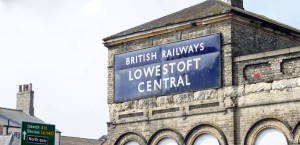
Image: J M Ritchie/Shutterstock.com
So now we have caught you up on all the best bits of Lowestoft, we had better explain how you get there, hadn’t we?
By Road
Follow the A143 southeast out of Norwich.
By Rail
Look for Lowestoft Train Station.
By Air
The nearest airport to the town is Norwich.
By Sea
Look for the Port of Lowestoft.
Five Minutes Spare
If you still have some free time to fill, head to our travel guide pages and have a browse. You might just find outa few things about your hometown and surrounding cities that you didn’t know before. The UK is full of adventures when you know where to look.

